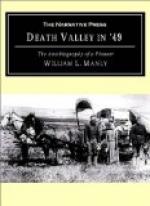They decided at first that they had better follow the stream southward, but after a little time, feeling the sickness caused by the water, they saw it was no advantage and turned west again, bearing to the north toward a sort of pass they could now see in the mountains in that direction. This stream is now known as the Amargosa, or bitter, river.
The new direction in which they marched gave them an up-hill route for thirty or forty miles, rough and barren, with no water or grass. There was no road or trail to follow, the oxen were as weak as their owners from drinking the bitter water, and the road needed some clearing and breaking in places before the wagons could pass. They moved quite slowly and reached the summit on the second night with the loss of a single ox. The Author would say here that this was the last ox which was allowed to die without using the flesh for food, and it was from this same one he cut a steak to eat on Christmas eve, 1849.
From the summit they took a way down a dark, deep canon having a steep slope, and very rocky and bad, but down which the oxen drew their loads much easier than when they came up, reaching water on the third day, where there were many springs, and a sort of coarse grass for the oxen. The place is now known as Furnace Creek. The Jayhawkers passed on, and here at these very springs was where the Author overtook the Rev. J.W. Brier delivering a lecture to his children on the benefits of an early education, as referred to in his narrative.
As the Jayhawkers drove out of this Furnace Creek Canon the valley into which they came was very narrow, the high, snow-capped mountain before them seemed steeper and rougher than ever, so steep in fact that it could not be ascended by a man on foot. A short distance below could be seen a lake containing water, and the pass toward which they had been directing their course seemed to the north of them. They therefore turned their course in that direction. The road was sandy, and the brush that grew on it




